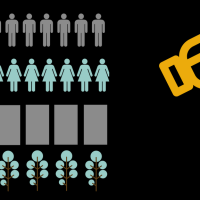Four years ago, on my first day at School of Planning and Architecture, I was told during the campus tour, that a lot of graduates don’t become architects. They become photographers, artists, furniture designers among other endless possibilities of profession. I was puzzled. I thought to myself “How does one get into the best architecture school and not end up pursuing architecture?”
And now, when I’m about to start my final year, I can say that I understand that first day’s dilemma rather clearly. However, this realisation didn’t dawn upon me in a split second epiphany. It’s been a journey that started with “Who is the Architect” in 3rd year Theory of Design, went on to a 30,000 word Dissertation titled “The Future Role of Architects in Society and Building Industry” in 4th year, where I explored the research question “How can architects in India make themselves relevant in the future?” And in the last 6 months through practical experience at two very different offices (at a traditional architecture and planning office, then at a multidisciplinary think tank that works within the domain of but is not limited to architectural solutions) as well as some hands-on building experience and community engagement with the ModSkool project.
I had initially thought of converting my Dissertation into multiple blog posts but I felt the urgent need to express my learnings from it, which I have already tried implementing in practical life. To give a brief background: I had 4 months to do the research and write it out. I reviewed existing literature, had multiple discussions with my guide(s), surveyed 30 students each from 1st Year (S1), 5th Year (S2) and practicing architects (S3) at SPA Delhi and conducted 4 expert interviews: Mr. Neeraj Manchanda, Mr. Gautam Bhatia, Mr. Vijay Garg and Mr. Snehanshu Mukherjee. So, here goes. 🙂
ABSTRACT
This Dissertation takes the reader into an unconventional place of questioning existence and purpose regarding the architectural profession. It is a kind of reflexivity that most in the profession would otherwise not engage in. That in itself makes it important to think beyond the normative and understand afresh what it means to be an architect in today’s complex Indian context, 44 years post the Architects Act of ’72. It is only then that one can attempt to deal with the paradox that faces our profession, and the flux our country finds itself in. In spite of being the expert on the creative front, the architect’s exclusive position is under threat and his/her value addition to the nation invisible.
The research conducted yields predictions and suggestions for future architects, based on the aspirations of students and expert foresight of practicing professionals. The future appears to be dominated by builders and large multidisciplinary firms. For small practices, it would mean getting limited to houses, unless a redefinition of the traditional role of an architect takes place. We need architect-activists and people willing to engage in both ‘design and build’ who can serve the masses, and not restrict themselves as designers for the richest clients (0.02% of India’s population) (Bhatia, 2016) (Mukherjee, 2016) (Manchanda, 2016) Owing to the diverse skill development in the architectural course, it will be possible to provide services beyond the built environment, in almost any field imaginable.
The need of our time is to look creatively at how architects can reinvent themselves to become more relevant in society and building industry and play meaningful roles to impact the built and unbuilt environments.
CONCLUSION
Here are the predictions and suggestions:
- In the last 25 years post Liberalisation, we have transitioned out of socialism into capitalism. (Mehrotra,2016) If one were to speculate looking at today’s situation, the future of architectural practice lies with builders and large multidisciplinary firms. (Mukherjee, 2016) (Manchanda, 2016) (Garg, 2016) (Survey 2,3) This is where the leadership qualities of an architect (refer 4.2) will be most needed, along with team work ethic by virtue of being a holistic professional.(Mukherjee, 2016) And it is here that architecture as a business will continue to proliferate. In such a situation, the business model and ethos come into question. The choice for young architects would be to join a commercial firm (large no. of architects go the developer way of minting money) or one which works with some sense of responsibility. (Mukherjee, 2016)There’s no point in pretending that, in most of the world, there’s anything other than a market, and its economic practices are going to drive change. So the question is how to get on board and make use of these mechanisms in a way that is constructive and creative. (Zimmerman cf Owen 2011)
“If the developer is playing a role in the building of our architectural physical fabric, then we will have to see where and how we can engage with that set of players. Real-estate is as much about planning, policy, and culture as much as it is economic and finance – this reality has to be elaborated, researched and explained, while as a profession we have to negotiate these forces for the larger good of our built and natural environments.” Rahul Mehrotra cf (Mehta, et al., 2015)
Following the trend seen in today’s time, the government will be hiring foreign firms as designer architects (branding), leaving large local firms as agents to execute the projects. Not only will the small firms find it hard to survive, the large firms will be in high competition due to undercutting. (Mukherjee, 2016)
- If young architects wish to own/work in a small practice, (the second largest no. according to Survey 2) they will primarily be building houses. However, there is great potential in India and a big market if one wishes to ‘design and build’ for the community i.e. informal sector, urban poor, underprivileged, lower middle class and not just the richest clients. (Mukherjee, 2016)(Bhatia, 2016) (Manchanda, 2016) For this, we need a public policy to help serve the masses (Garg, 2016) or a business model which facilitates social work such as balancing between working for the richest and poorest. (Bhatia, 2016) Practices involved with research, activism and willing to collaborate will be essential to convert opportunities into meaningful change (Sameep Padora cf Srivatsan, 2016) We probably need more Achitect-Activists.(refer 4.4) (Mukherjee, 2016)
Kaiwan Mehta of Domus magazine in a feature clip on NDTV says “So somewhere the architect will have to recover the role of the activist, the person who willingly engaged with society through the act of building making, not denying the act of building making” (NDTV, 2016)
The experts’ advice matches with future architects’ aspirations. The young generation sees architecture as a tool to improve lives of the majority of India’s population. This is a positive outlook and understanding of our country’s need and the profession’s potential role. (Rural upliftment is considered to be the major role of the architectural profession in India, an overwhelming majority feels that architects should be serving the underprivileged, then then middle class and the minority lies with the corporates and upper class.)
- The future architects need multidisciplinary learning and perhaps inter course collaborations at B.Arch level could be a way to learn many disciplines and know the principles. (Survey 3) It is only when they challenge the principles and question everything around them that innovation will happen. And innovation is essential in India’s context, if we are to stop looking West and East and evolve culturally rooted solutions of our own. (Bhatia, 2016)(Mukherjee, 2016) According to Ratnam(2016) there can’t be one solution for the entire country in today’s time. The built environment is a local concern and we need plural voices and development of forms of leadership at local levels.
- In order to stay relevant, the author has recognized that it is imperative to first be clear of one’s purpose and philosophical position-both as an individual architect and as a professional community. It is only when one realises and accepts a certain role and responsibility that productive action will follow. (Manchanda, 2016)There is an urgent need for the architecture profession to come together as a community and define the professions’ larger common goals for the nation. Currently the profession doesn’t have a strong enough voice as there is no sense of community. This is interconnected with lack of resolution in issues that the profession faces such as lack of standardisation for fees. (Survey 3)(Bhatia, 2016) (Mukherjee, 2016)
- The profession’s value addition currently is not visible to anybody in the country, outside the profession.(Manchanda, 2016) Spreading awareness about the role of architecture seems to be a highly agreed upon point. (Survey 1,2,3) Good design will follow from good demand by the public. (Surveys 1 and 2 show great confusion regarding the role of an architect and inability to communicate to even friends and family what architecture entails)
- Redefinition of an architect’s role by getting involved in services beyond the built environment will be possible. The architect’s role is most widely accepted as comprising of shaping the physical environments, keeping in mind the client’s interest and a wide range of contextual considerations. An alternative definition of looking at the architect as someone who ‘designs solutions, not necessarily buildings, and not necessarily for the largest client’ opens up untapped possibilities for areas of work beyond the built environment. (Mukherjee, 2016) This is apparent from the fact that almost 50% of the 5th year students are doubtful regarding continuing with architecture. When asked about an alternative profession: writer, graphic designer, social activist seem popular. (Surveys 1 and 2 show interest in Art, followed by Science being the main reason to join architecture, interest in Sociology is prominent by 5th Year) Moreover the role of an architect is understood to entail social sensitivity at the highest, then creative input followed by problem solving of any nature. Serving the clients’ interest and project managing are seen as the least part of an architect’s role. This reflects the aspirational role of an architect, not necessarily the most observed one. This is interesting, because in practice the clients interest (Manchanda, 2016) and project managing become the major roles and the other three form a small percentage. Hence a need is observed to provide services beyond traditionally defined realms.
WAY FORWARD
This Dissertation may have offered possible solutions to the research question and given a certain direction for the future. At the same time, it has raised many more questions. If our nation is in a state of flux and in a time where solutions to our problems need to be our own, this Dissertation offers a point of reflection and pondering regarding purpose and philosophy associated with the architectural profession. This may be a necessary step in the direction that we need to take to contribute constructively to India’s development, problem solving and our professions relevance/value addition as a result. It is also an important step in translating our education’s intentions into the real Indian context as we see it today and in the near future.
Thanks for reading till the end! 🙂
If you haven’t already, do read 1 and 2 as build-ups to this post.
Also, if you want to read a blog post about any of the following topics, let me know!
- Why Architecture is considered a ‘Profession’
- The State of the Architectural Profession in India
- Architects Act 1972 , COA and Professional Conduct Guidelines
- The Architect as a Creative
- The Architect as a Manager
- The Architect as a Generalist and Problem Solver
- The Architect as a Social Activist
Source:
If you wish to cite from the content in this blog post, please use the following information:
Dissertation: Future Role of Architects in Society and Building Industry by Kanchan Joneja, 2016, Department of Architecture, School of Planning and Architecture, New Delhi
(Joneja, 2016)






July 14, 2017 at 5:07 AM
Hi! This was brilliant! I would want to know more about ‘Architect as a social activist’! I’d be more than happy if you share your research and views on the same since I’m working in a similar direction, and this might actually help in putting things in perspective
LikeLiked by 1 person
July 14, 2017 at 8:43 AM
Hey! Thanks so much for the appreciation and feedback! I’ll work on it and share it soon 🙂 p.s. I’m working in a similar direction too.
LikeLike
July 17, 2017 at 11:05 AM
hmm…not to be critical, but what architects need to lose first and foremost is the sense of ‘self’ and therefore ‘self-importance’ .
do we really make a change? will the world cease to exist if we do. no it wont. then what are we bringing to the table really.
and about not many architecture students wanting to continue as ‘architects’ , always been true.
in a long ago paper i had argued that architectural education is , in india, the closest we can get to a liberal arts education (this is pre 2010 or nearabouts, before the Ashoka Universties et al turned up). so my argument: it’s a liberal arts education , with the safety net of a professional degree thrown in. so it woks extremely work for the indian psyche.
more anon and should you be interested 🙂
keep at it though.
LikeLiked by 2 people
July 17, 2017 at 11:37 AM
I agree with you. The world will not cease to exist without architects. In fact, in the future we might not even have architects. I think I had a discussion with Snehanshu Sir about how the architecture course is like, but better than liberal arts because there’s a tangibility to problem solving/ the product i.e. a platform to apply systems thinking in a manner. I would love to read that paper if possible? 🙂 Thank you so much for the insights!
LikeLike
July 23, 2017 at 4:22 PM
Truly professional. Keep up the intensity 👍
LikeLiked by 1 person